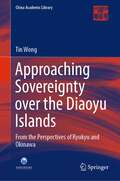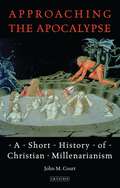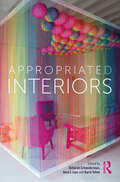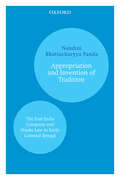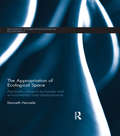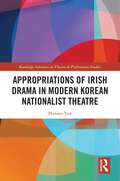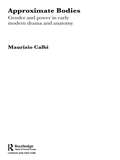- Table View
- List View
Approaching Sovereignty over the Diaoyu Islands: From the Perspectives of Ryukyu and Okinawa (China Academic Library)
by Tin WongThis book discusses the sovereignty over the Diaoyu Islands from the perspectives of Ryukyu and Okinawa. Written in chronological order, the book has 13 chapters featuring 121 documents and maps. The first 12 chapters explain, based on detailed historical facts on the Diaoyu Islands, the rise and decline of the Ryukyu Kingdom and the historical roles of China, Japan, and the United States in the history of the kingdom. The final chapter is an overview of the Sino-Ryukyuan, Japan-Ryukyuan and US-Ryukyuan relations, and further clarifies the issue of ownership of the Diaoyu Islands and their strategic position. The book demonstrates that Ryukyu did not have sovereignty over the Diaoyu Islands, refutes Japan’s claim that these islands were a part of the Ryukyu Kingdom, and reveals the causes and consequences of the Sino-Japanese conflicts created by the United States. The book examines the 500-year friendship between China and Ryukyu, recounting moving stories. Lastly, citing ancient documents and more, the books proves that the Ryukyus never owned the Diaoyu Islands and that these islands belong to China.
Approaching the Apocalypse: A Short History of Christian Millenarianism
by John M. CourtPestilence, earthquake and flame; the binding of the great beast and the opening of seven seals: such ideas about divinely-inspired disaster and prophecies of doom have an enduring place in the history of Christian thought. For centuries men and women have made preparations for the imminent end of the world, and for the thousand year reign of Christ and his saints. Inspired principally by the startling texts of the Book of Revelation, Christianity has a rich and varied tradition of looking forward to the purifying fires of Armageddon. But what do recurring motifs like the Rapture, the apocalyptic Four Horsemen, plague, utopias, biblical prophecy and the building of the New Jerusalem really add up to? And how have understandings and interpretations of these patterns differed from century to century? Charting a steady course between the feverish predictions of early Christian heretics like the Montanists, whose leader was considered to be a manifestation of the Holy Spirit, and the febrile outpourings of modern-day, right-wing millennialists such as the Christian Zionists in America, John M Court explores the continuities and differences between their violent visions of cataclysm. His concise history offers an incisive analysis of such significant movements and figures as Joachim of Fiore, the Levellers and Diggers, James Jezreel and his Trumpeters, William Miller and Joanna Southcott, Seventh-Day Adventists and Jehovah's Witnesses, David Koresh and the Branch Davidians, and modern-day cargo cults and drug cultures. Embracing over two thousand years of intense and fiery admonition, Approaching the Apocalypse offers students of religion, history and politics the definitive handbook to Doomsday.
Approaching the Bible in medieval England (Manchester Medieval Studies #8)
by Eyal PolegHow did people learn their Bibles in the Middle Ages? Did church murals, biblical manuscripts, sermons or liturgical processions transmit the Bible in the same way? This book unveils the dynamics of biblical knowledge and dissemination in thirteenth- and fourteenth-century England. An extensive and interdisciplinary survey of biblical manuscripts and visual images, sermons and chants, reveals how the unique qualities of each medium became part of the way the Bible was known and recalled; how oral, textual, performative and visual means of transmission joined to present a surprisingly complex biblical worldview. This study of liturgy and preaching, manuscript culture and talismanic use introduces the concept of biblical mediation, a new way to explore Scriptures and society. It challenges the lay-clerical divide by demonstrating that biblical exegesis was presented to the laity in non-textual means, while the ‘naked text’ of the Bible remained elusive even for the educated clergy.
Approaching the Bible in medieval England (Manchester Medieval Studies #8)
by Eyal PolegHow did people learn their Bibles in the Middle Ages? Did church murals, biblical manuscripts, sermons or liturgical processions transmit the Bible in the same way? This book unveils the dynamics of biblical knowledge and dissemination in thirteenth- and fourteenth-century England. An extensive and interdisciplinary survey of biblical manuscripts and visual images, sermons and chants, reveals how the unique qualities of each medium became part of the way the Bible was known and recalled; how oral, textual, performative and visual means of transmission joined to present a surprisingly complex biblical worldview. This study of liturgy and preaching, manuscript culture and talismanic use introduces the concept of biblical mediation, a new way to explore Scriptures and society. It challenges the lay-clerical divide by demonstrating that biblical exegesis was presented to the laity in non-textual means, while the ‘naked text’ of the Bible remained elusive even for the educated clergy.
Approaching the Roman Revolution: Papers on Republican History
by Ronald SymeThis volume collects twenty-six previously unpublished studies on Republican history by the late Sir Ronald Syme (1903-1989), drawn from the archive of Syme's papers at the Bodleian Library. This set of papers sheds light on aspects of Republican history that were either overlooked or tangentially discussed in Syme's published work. They range across a wide spectrum of topics, including the political history of the second century BC, the age of Sulla, the conspiracy of Catiline, problems of constitutional law, and the Roman conquest of Umbria. Each of them makes a distinctive contribution to specific historical problems. Taken as a whole, they enable us to reach a more comprehensive assessment of Syme's intellectual and historiographical profile. The papers are preceded by an introduction that places them within the context of Syme's work and of the current historiography on the Roman Republic, and are followed by a full set of bibliographical addenda.
Approaching the Roman Revolution: Papers on Republican History
by Ronald SymeThis volume collects twenty-six previously unpublished studies on Republican history by the late Sir Ronald Syme (1903-1989), drawn from the archive of Syme's papers at the Bodleian Library. This set of papers sheds light on aspects of Republican history that were either overlooked or tangentially discussed in Syme's published work. They range across a wide spectrum of topics, including the political history of the second century BC, the age of Sulla, the conspiracy of Catiline, problems of constitutional law, and the Roman conquest of Umbria. Each of them makes a distinctive contribution to specific historical problems. Taken as a whole, they enable us to reach a more comprehensive assessment of Syme's intellectual and historiographical profile. The papers are preceded by an introduction that places them within the context of Syme's work and of the current historiography on the Roman Republic, and are followed by a full set of bibliographical addenda.
Approaching the Tsinghua Bamboo Slips (ISSN)
by Guozhong LiuThis book provides a detailed introduction to the study of the Tsinghua Bamboo Slips, explaining the preservation and analysis of the artifacts and their significance in historical research of the pre-Qin period.The Tsinghua Bamboo Slips are a collection of Chinese texts inscribed on approximately 2,500 bamboo slips. They were excavated from a Warring States Period tomb and are now preserved at Tsinghua University. The book delves into the traditions and discoveries of bamboo manuscripts in China and discusses the preservation and research of the slips, covering the procedures of artifact processing, authentication, digitization, editing, and interpretation. The manuscripts are remarkable for their quantity, period of creation, and distinctive content coverage. They contain important historical documents that differ from or are missing from the extant literature. The analysis of these texts helps to unravel some of the unresolved mysteries in pre-Qin historical studies and illuminates scientific achievements of ancient China previously unknown to the world.This book is essential reading for scholars and students of Chinese studies, pre-Qin history, and early literacy. It will also appeal to general readers interested in ancient Chinese history and culture.
Approaching the Tsinghua Bamboo Slips (ISSN)
by Guozhong LiuThis book provides a detailed introduction to the study of the Tsinghua Bamboo Slips, explaining the preservation and analysis of the artifacts and their significance in historical research of the pre-Qin period.The Tsinghua Bamboo Slips are a collection of Chinese texts inscribed on approximately 2,500 bamboo slips. They were excavated from a Warring States Period tomb and are now preserved at Tsinghua University. The book delves into the traditions and discoveries of bamboo manuscripts in China and discusses the preservation and research of the slips, covering the procedures of artifact processing, authentication, digitization, editing, and interpretation. The manuscripts are remarkable for their quantity, period of creation, and distinctive content coverage. They contain important historical documents that differ from or are missing from the extant literature. The analysis of these texts helps to unravel some of the unresolved mysteries in pre-Qin historical studies and illuminates scientific achievements of ancient China previously unknown to the world.This book is essential reading for scholars and students of Chinese studies, pre-Qin history, and early literacy. It will also appeal to general readers interested in ancient Chinese history and culture.
Appropriated Interiors
by Deborah Schneiderman Anca I. Lasc Karin TehveAppropriated Interiors uncovers the ways interiors participate explicitly and implicitly in embedded cultural and societal values and explores timely emergent scholarship in the fields of interior design history, theory, and practice. What is "appropriate" and "inappropriate" now? These are terms with particular interest to the study of the interior. Featuring thirteen original curated essays, Appropriated Interiors explores the tensions between normative interiors that express the dominant cultural values of a society and interiors that express new, changing, and even transgressive values. With case studies from the late eighteenth century to the twenty-first century, these historians, theorists, and design practitioners investigate the implications of interior design as it relates to politics, gender, identity, spatial abstraction, cultural expression, racial expression, technology, and much more. An informative read for students and scholars of design history and theory, this collection considers the standards, assumptions, codes, and/or conventions that need to be dismantled and how we can expand our understanding of the history, theory, and practice of interior design to challenge the status quo.
Appropriated Interiors
by Deborah Schneiderman Anca I. Lasc Karin TehveAppropriated Interiors uncovers the ways interiors participate explicitly and implicitly in embedded cultural and societal values and explores timely emergent scholarship in the fields of interior design history, theory, and practice. What is "appropriate" and "inappropriate" now? These are terms with particular interest to the study of the interior. Featuring thirteen original curated essays, Appropriated Interiors explores the tensions between normative interiors that express the dominant cultural values of a society and interiors that express new, changing, and even transgressive values. With case studies from the late eighteenth century to the twenty-first century, these historians, theorists, and design practitioners investigate the implications of interior design as it relates to politics, gender, identity, spatial abstraction, cultural expression, racial expression, technology, and much more. An informative read for students and scholars of design history and theory, this collection considers the standards, assumptions, codes, and/or conventions that need to be dismantled and how we can expand our understanding of the history, theory, and practice of interior design to challenge the status quo.
Appropriating Antiquity for Modern Chinese Painting
by Chia-Ling YangThe pursuit of antiquity was important for scholarly artists in constructing their knowledge of history and cultural identity in late imperial China. By examining versatile trends within paintings in modern China, this book questions the extent to which historical relics have been used to represent the ethnic identity of modern Chinese art. In doing so, this book asks: did the antiquarian movements ultimately serve as a deliberate tool for re-writing Chinese art history in modern China?In searching for the public meaning of inventive private collecting activity, Appropriating Antiquity in Modern Chinese Painting draws on various modes of artistic creation to address how the use of antiquities in early 20th-century Chinese art both produced and reinforced the imaginative links between ancient civilization and modern lives in the late Qing dynasty. Further exploring how these social and cultural transformations were related to the artistic exchanges happening at the time between China, Japan and the West, the book successfully analyses how modernity was translated and appropriated at the turn of the 20th century, throughout Asia and further afield.
Appropriating Antiquity for Modern Chinese Painting
by Chia-Ling YangThe pursuit of antiquity was important for scholarly artists in constructing their knowledge of history and cultural identity in late imperial China. By examining versatile trends within paintings in modern China, this book questions the extent to which historical relics have been used to represent the ethnic identity of modern Chinese art. In doing so, this book asks: did the antiquarian movements ultimately serve as a deliberate tool for re-writing Chinese art history in modern China?In searching for the public meaning of inventive private collecting activity, Appropriating Antiquity in Modern Chinese Painting draws on various modes of artistic creation to address how the use of antiquities in early 20th-century Chinese art both produced and reinforced the imaginative links between ancient civilization and modern lives in the late Qing dynasty. Further exploring how these social and cultural transformations were related to the artistic exchanges happening at the time between China, Japan and the West, the book successfully analyses how modernity was translated and appropriated at the turn of the 20th century, throughout Asia and further afield.
Appropriating History: The Soviet Past in Belarusian, Russian and Ukrainian Popular Culture (Historische Lebenswelten in populären Wissenskulturen/History in Popular Cultures #21)
by Matthias Schwartz Nina WellerPopular media play an important role in reconstructing collective imaginations of history. Dramatic events and ruptures of the 20th century provide the material for playful as well as neo-imperialist and nationalist appropriations of the past. The contributors to the volume investigate this phenomenon using case studies from Belarusian, Russian and Ukrainian popular cultures. They show how in mainstream films, TV series, novels, comics and computer games, the reference to Soviet history offers role models, action patterns and even helps to justify current political and military developments. The volume thus presents new insights into the multi-layered and explosive dynamics of popular culture in Eastern Europe.
Appropriating Hobbes: Legacies in Political, Legal, and International Thought
by David BoucherThis book explores how Hobbes's political philosophy has occupied a pertinent place in different contexts, and how his interpreters see their own images reflected in him, or how they define themselves in contrast to him. Appropriating Hobbes argues that there is no Hobbes independent of the interpretations that arise from his appropriation in these various contexts and which serve to present him to the world. There is no one perfect context that enables us to get at what Hobbes 'really meant', despite the numerous claims to the contrary. He is almost indistinguishable from the context in which he is read. This contention is justified with reference to hermeneutics, and particularly the theories of Gadamer, Koselleck, and Ricoeur, contending that through a process of 'distanciation' Hobbes's writings have been appropriated and commandeered to do service in divergent contexts such as philosophical idealism; debates over the philosophical versus historical understanding of texts; as well as in ideological disputations, and emblematic characterisations of him by various disciplines such as law, politics, and international relations. This volume illustrates the capacity of a text to take on the colouration of its surroundings by exploring and explicating the importance of contexts in reading and understanding how and why particular interpretations of Hobbes have emerged, such as those of Carl Schmitt and Michael Oakeshott, or the international jurists of the seventeenth, eighteenth, and nineteenth centuries.
Appropriating Hobbes: Legacies in Political, Legal, and International Thought
by David BoucherThis book explores how Hobbes's political philosophy has occupied a pertinent place in different contexts, and how his interpreters see their own images reflected in him, or how they define themselves in contrast to him. Appropriating Hobbes argues that there is no Hobbes independent of the interpretations that arise from his appropriation in these various contexts and which serve to present him to the world. There is no one perfect context that enables us to get at what Hobbes 'really meant', despite the numerous claims to the contrary. He is almost indistinguishable from the context in which he is read. This contention is justified with reference to hermeneutics, and particularly the theories of Gadamer, Koselleck, and Ricoeur, contending that through a process of 'distanciation' Hobbes's writings have been appropriated and commandeered to do service in divergent contexts such as philosophical idealism; debates over the philosophical versus historical understanding of texts; as well as in ideological disputations, and emblematic characterisations of him by various disciplines such as law, politics, and international relations. This volume illustrates the capacity of a text to take on the colouration of its surroundings by exploring and explicating the importance of contexts in reading and understanding how and why particular interpretations of Hobbes have emerged, such as those of Carl Schmitt and Michael Oakeshott, or the international jurists of the seventeenth, eighteenth, and nineteenth centuries.
Appropriation and Invention of Tradition: The East India Company and Hindu Law in Early Colonial Bengal
by Nandini Bhattacharyya PandaThis book, strongly grounded in primary sources, makes an important contribution to the intellectual history of early modern Bengal. It brings to light the complex interpenetration of diverse interests, opinions, and ideologies articulated by various social groups implicated in the process of colonization on the lines of Ranajit Guha's work on property relations in Bengal and Radhika Singha's work on law. There is no comparable work specifically on the subject of Hindu property rights and how these came to be perceived or interpreted in early modern Bengal. The author explores the so-called compendia prepared under British auspices and argues that there was hardly any link between the Smritis and the laws. The latter were determined almost entirely by changing British policy with regard to land revenue and that many of the positive features of Hindu custom like women's rights to property were undermined in the process.
The Appropriation of Ecological Space: Agrofuels, unequal exchange and environmental load displacements (Routledge Studies in Ecological Economics)
by Kenneth HermeleAlthough it is recognised that Thomas Robert Malthus was wrong when he posited a contradiction between population increase and agricultural growth, there are increasing signs that he could be proved right in the future. Perhaps Malthus was too late and too early in his prediction? He was too late, because he did not foresee the shift from land-based resources to fossil fuels, outing an end to the limits of agricultural growth, at least temporarily; and he was too early to witness that fossil fuels would come up against their own limits in terms of supply as well as in terms of global warming. This study deals with land-based resources and the role they play in the global socio-ecological metabolic regime, both now and in the future. In particular, the controversial use of agrofuels as a solution to coming scarcity is subjected to close scrutiny.
The Appropriation of Ecological Space: Agrofuels, unequal exchange and environmental load displacements (Routledge Studies in Ecological Economics)
by Kenneth HermeleAlthough it is recognised that Thomas Robert Malthus was wrong when he posited a contradiction between population increase and agricultural growth, there are increasing signs that he could be proved right in the future. Perhaps Malthus was too late and too early in his prediction? He was too late, because he did not foresee the shift from land-based resources to fossil fuels, outing an end to the limits of agricultural growth, at least temporarily; and he was too early to witness that fossil fuels would come up against their own limits in terms of supply as well as in terms of global warming. This study deals with land-based resources and the role they play in the global socio-ecological metabolic regime, both now and in the future. In particular, the controversial use of agrofuels as a solution to coming scarcity is subjected to close scrutiny.
The Appropriation of Religion in Southeast Asia and Beyond
by Michel PicardThis volume investigates various processes by which world religions become localized, as well as how local traditions in Southeast Asia and Melanesia become universalized. In the name of modernity and progress, the contemporary Southeast Asian states tend to press their populations to have a ‘religion,' claiming that their local, indigenous practices and traditions do not constitute religion. Authors analyze this ‘religionization,’ addressing how local people appropriate religion as a category to define some of their practices as differentiated from others, whether they want to have a religion or are constrained to demonstrate that they profess one. Thus, ‘religion’ is what is regarded as such by these local actors, which might not correspond to what counts as religion for the observer. Furthermore, local actors do not always concur regarding what their religion is about, as religion is a contested issue. In consequence, each of the case studies in this volume purposes to elucidate what gets identified and legitimized as ‘religion’, by whom, for what purpose, and under what political conditions.
The Appropriation of Religion in Southeast Asia and Beyond
by Michel PicardThis volume investigates various processes by which world religions become localized, as well as how local traditions in Southeast Asia and Melanesia become universalized. In the name of modernity and progress, the contemporary Southeast Asian states tend to press their populations to have a ‘religion,' claiming that their local, indigenous practices and traditions do not constitute religion. Authors analyze this ‘religionization,’ addressing how local people appropriate religion as a category to define some of their practices as differentiated from others, whether they want to have a religion or are constrained to demonstrate that they profess one. Thus, ‘religion’ is what is regarded as such by these local actors, which might not correspond to what counts as religion for the observer. Furthermore, local actors do not always concur regarding what their religion is about, as religion is a contested issue. In consequence, each of the case studies in this volume purposes to elucidate what gets identified and legitimized as ‘religion’, by whom, for what purpose, and under what political conditions.
Appropriations of Irish Drama in Modern Korean Nationalist Theatre (Routledge Advances in Theatre & Performance Studies)
by Hunam YunThis book investigates the translation field as a hybrid space for the competing claims between the colonisers and the colonised. By tracing the process of the importation and appropriation of Irish drama in colonial Korea, this study shows how the intervention of the competing agents – both the colonisers and the colonised – formulates the strategies of representation or empowerment in the rival claims of the translation field. This exploration will be of great interest to students and scholars of theatre and performance studies, translation studies, and Asian studies.
Appropriations of Irish Drama in Modern Korean Nationalist Theatre (Routledge Advances in Theatre & Performance Studies)
by Hunam YunThis book investigates the translation field as a hybrid space for the competing claims between the colonisers and the colonised. By tracing the process of the importation and appropriation of Irish drama in colonial Korea, this study shows how the intervention of the competing agents – both the colonisers and the colonised – formulates the strategies of representation or empowerment in the rival claims of the translation field. This exploration will be of great interest to students and scholars of theatre and performance studies, translation studies, and Asian studies.
Approved Schools for Girls in England, 1933-1973: ‘Girls will be Girls’ (Palgrave Studies in the History of Childhood)
by Jessamy CarlsonThis book provides a detailed study of approved schools for girls, which operated in England and Wales between 1933-1973. Through original archival research, it traces shifting perceptions of, and policy responses to, girls’ delinquency and vulnerability during a period of remarkable social change. It examines the transition of provision for girls and young women 'in trouble' from the large-scale post-Victorian reformatories to the therapeutic Community Homes for Education, and the emergence of a 'diagnostic shift' in the provision of care for children in the juvenile secure estate. Through examining the experiences of younger children, it provides a more nuanced understanding of the role approved schools played for girls in need of care, protection, or control during this period, evidencing the gendered use of care-or-protection orders throughout, and the policing of child and family behaviours under the guises of the Education Act.
Approximate Bodies: Gender and Power in Early Modern Drama and Anatomy
by Maurizio CalbiThe early modern period was an age of anatomical exploration and revelation, with new discoveries capturing the imagination not only of scientists but also of playwrights and poets. Approximate Bodies examines, in fascinating detail, the changing representation of the body in early modern drama and in the period's anatomical and gynaecological treatises. Maurizio Calbi focuses on the unstable representation of both masculinity and femininity in Renaissance texts such as The Duchess of Malfi, The Changeling and a variety of Shakespeare plays. Drawing on theorists including Foucault, Derrida and Lacan, these close textual readings examine the effects of social, psychic and cultural influences on early modern images of the body. Calbi identifies the ways in which political, social, racial and sexual power structures effect the construction of the body in dramatic and anatomical texts. Calbi's analysis displays how images such as the deformed body of the outsider, the effeminate body of the desiring male and the disfigured body parts of the desiring female indicate an unstable, incomplete conception of the body in the Renaissance. Compelling and impeccably researched, this is a sophisticated account of the fantasies and anxieties that play a role in constructing the early modern body. Approximate Bodies makes a major contribution to the field of early modern studies and to debates around the body.
Approximate Bodies: Gender and Power in Early Modern Drama and Anatomy
by Maurizio CalbiThe early modern period was an age of anatomical exploration and revelation, with new discoveries capturing the imagination not only of scientists but also of playwrights and poets. Approximate Bodies examines, in fascinating detail, the changing representation of the body in early modern drama and in the period's anatomical and gynaecological treatises. Maurizio Calbi focuses on the unstable representation of both masculinity and femininity in Renaissance texts such as The Duchess of Malfi, The Changeling and a variety of Shakespeare plays. Drawing on theorists including Foucault, Derrida and Lacan, these close textual readings examine the effects of social, psychic and cultural influences on early modern images of the body. Calbi identifies the ways in which political, social, racial and sexual power structures effect the construction of the body in dramatic and anatomical texts. Calbi's analysis displays how images such as the deformed body of the outsider, the effeminate body of the desiring male and the disfigured body parts of the desiring female indicate an unstable, incomplete conception of the body in the Renaissance. Compelling and impeccably researched, this is a sophisticated account of the fantasies and anxieties that play a role in constructing the early modern body. Approximate Bodies makes a major contribution to the field of early modern studies and to debates around the body.
